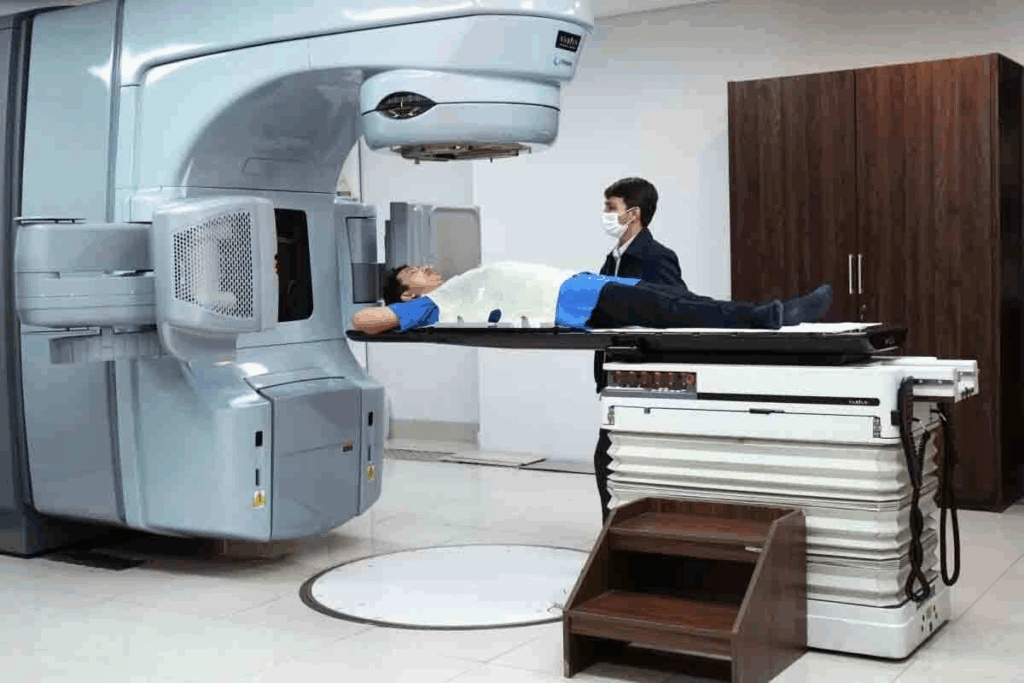Last Updated on November 27, 2025 by Bilal Hasdemir

At Liv Hospital, we focus on precise and effective cancer treatment. Internal radiation treatment, also known as brachytherapy, is key. It targets cancer cells while keeping healthy tissues safe.
This method uses sealed radiation therapy implants or radioactive materials. They are placed directly into the tissues to be treated. This way, we get more precise results and often cut down treatment times.
Our patient-centered approach is recognized worldwide. It focuses on delivering top-notch healthcare with full support. As we explore further, you’ll see the benefits and key facts about internal radiotherapy treatment. It’s a trusted choice for patients globally.
Key Takeaways
- Internal radiation treatment targets cancer cells precisely.
- Brachytherapy involves sealed radiation therapy implants.
- This approach often results in shorter treatment times.
- Liv Hospital offers a patient-centered, internationally recognized approach.
- Internal radiotherapy treatment is effective for various cancers.
- Our support guides patients through treatment.
Understanding Internal Radiation Treatment and Its Purpose
Internal radiation therapy, also known as brachytherapy, is a method to treat cancer. It delivers radiation directly to the tumor. This method gives a high dose of radiation to the cancer while protecting healthy tissues.
Definition and Basic Principles
Internal radiation therapy places a radioactive source inside the body. It can be in solid or liquid form. The choice depends on the cancer type, location, and stage.
This therapy aims to give precise radiation to the tumor. It does this by carefully planning and placing the radioactive material. This way, it maximizes the effect on the tumor while protecting healthy tissues.
Key aspects of internal radiation therapy include:
- Direct delivery of radiation to the tumor site
- Minimized exposure to surrounding healthy tissues
- Potential for higher doses of radiation compared to external beam radiation therapy
- Variety of radioactive materials and delivery methods available
How It Differs from External Radiation
External radiation therapy directs radiation from outside the body to the tumor. Internal radiation therapy places the source inside or near the tumor. This difference affects how the radiation is delivered and its impact.
Internal radiation therapy is great for treating small, accessible tumors. It delivers a high dose of radiation directly to the cancer cells. This reduces damage to surrounding tissues.
The main differences between internal and external radiation therapy are:
- Location of the radiation source: Internal radiation is placed inside the body, while external radiation comes from outside.
- Radiation dose delivery: Internal radiation can deliver a higher dose directly to the tumor.
- Treatment duration: Internal radiation therapy can sometimes be completed in a shorter duration compared to external radiation.
The Science Behind Brachytherapy Radiotherapy
Brachytherapy radiotherapy uses radioactive isotopes to kill cancer cells while keeping healthy tissue safe. It’s a local treatment that focuses on a specific area of the body. This makes it a good choice for many types of cancer.
Radioactive Materials Used in Treatment
Brachytherapy uses different radioactive materials, or isotopes, based on the cancer type and tumor location. Common ones include Iodine-125, Palladium-103, and Cesium-131. These isotopes release radiation that harms cancer cells’ DNA, stopping them from growing and eventually killing them.
The right isotope is picked based on its half-life, radiation energy, and tumor characteristics.
How Radiation Affects Cancer Cells
When radioactive materials are placed near a tumor, they damage cancer cells’ DNA. This stops them from growing. This method lets doctors give more radiation to the tumor, making treatment more effective and safer for healthy tissues.
The radiation from brachytherapy can make cancer cells die naturally. This is key to getting rid of cancer cells and stopping tumors from coming back.
In short, brachytherapy radiotherapy is a precise and effective way to fight cancer. It uses radioactive materials to target and kill cancer cells. Knowing how it works helps patients understand its benefits and what to expect.
Types of Sealed Radiation Implants
Sealed radiation implants are key in brachytherapy, a precise cancer treatment. They contain radioactive material placed close to the tumor. This allows for targeted radiation.
Temporary Implants and Their Applications
Temporary implants are used in some brachytherapy treatments. They are placed in the body for a short time. These implants treat cancers like cervical, prostate, and breast cancer.
The benefits of temporary implants include:
- High dose rate (HDR) brachytherapy, which delivers radiation in a short period
- Flexibility in treatment planning and delivery
- The ability to remove the implant after treatment, reducing long-term radiation exposure
Permanent Seeds and Implantable Devices
Permanent seeds, or low-dose rate (LDR) brachytherapy, involve small radioactive seeds in the tumor. These seeds stay in the body forever but lose radioactivity over time.
Permanent seeds are commonly used to treat:
- Prostate cancer
- Certain types of lung cancer
- Other localized tumors
Delivery Methods: Seeds, Ribbons, and Wires
The delivery method for sealed radiation implants depends on the cancer type and treatment plan. Common methods include:
| Delivery Method | Description | Common Applications |
| Seeds | Small radioactive particles implanted directly into the tumor | Prostate cancer, lung cancer |
| Ribbons | Thin, flexible ribbons containing radioactive material | Cervical cancer, other gynecological cancers |
| Wires | Thin wires used to guide the placement of radioactive material | Various cancers, including head and neck cancers |
Understanding the different sealed radiation implants helps tailor treatments to each patient. This makes brachytherapy more effective.
How Internal Radiation Treatment Works in Practice
Internal radiation treatment is a precise way to fight cancer. It places radioactive sources right at the tumor. This method is called brachytherapy treatment. It’s used for many cancers, like those in the head, neck, breast, cervix, prostate, and eye.
Intracavitary Brachytherapy Procedures
Intracavitary brachytherapy puts a radioactive source in a body cavity, like the vagina or cervix. It’s mainly for gynecological cancers. A special device is used to insert the radioactive material.
The procedure is done under general anesthesia or sedation to reduce pain. It can last from a few minutes to several days, based on the radiation dose.
Interstitial Brachytherapy Techniques
Interstitial brachytherapy implants small radioactive sources into the tumor or nearby tissue. It treats cancers in the prostate, breast, and head and neck. The sources can be seeds, ribbons, or wires.
The choice of material and technique depends on the cancer type and location. A special applicator is used to place the sources.
Surface Applications for Skin Cancers
For skin cancers, surface brachytherapy is a good option. It places a radioactive source on the skin over the tumor. The dose is set to hit the cancer cells while protecting healthy tissue.
Surface brachytherapy is great for skin cancers that are hard to treat with surgery or external radiation.
Cancer Types Effectively Treated with Brachy Radiation Treatment
Brachy radiation treatment helps many cancer types. It’s used for head and neck, breast, cervix, prostate, and eye cancers. Let’s look at how it treats these cancers.
Prostate Cancer Applications
Brachytherapy is a key treatment for prostate cancer. It places radioactive seeds in the prostate. This method targets the tumor well, protecting healthy tissues.
Brachytherapy works best for low to intermediate-risk prostate cancer patients.
Gynecological Cancers: Cervical and Endometrial
Brachytherapy treats cervical and endometrial cancers well. It places radioactive material near the tumor. This method boosts local control and survival rates.
Breast Cancer Treatment Options
Brachytherapy is used for early-stage breast cancer. Accelerated partial breast irradiation (APBI) is a fast treatment option. It’s shorter than traditional whole-breast irradiation.
Head, Neck, and Other Cancer Sites
Brachytherapy treats head and neck cancers, and others like the eye. It’s flexible, tailored to each patient and tumor. For head and neck cancers, it can be used alone or with external beam radiation.
In summary, brachy radiation treatment is versatile and effective for many cancers. Its targeted radiation makes it a powerful tool against cancer.
Benefits of Internal Radiotherapy Treatment
Cancer patients can greatly benefit from internal radiotherapy. It targets the tumor directly. This method delivers high doses of radiation to the tumor, while keeping healthy tissues safe.
Precision and Targeted Radiation Delivery
Internal radiotherapy is known for its precision radiation. The radiation source is placed close to the tumor. This ensures cancer cells get the needed dose to fight the disease.
This method boosts treatment effectiveness and lowers the risk of harming healthy tissues. Patients face fewer side effects and enjoy a better quality of life.
Minimized Exposure to Healthy Tissues
Internal radiotherapy aims to minimize exposure to healthy tissues. Radiation is sent directly to the tumor. This is key in sensitive areas where external radiation could cause harm.
Less radiation to healthy tissues means fewer side effects for patients. This makes treatment more bearable and speeds up recovery.
Shorter Treatment Times and Recovery
Internal radiotherapy can lead to shorter treatment times. Radiation is delivered right to the tumor. This makes treatment faster than external radiation therapy.
Shorter treatments are less taxing on patients. They can get back to their lives sooner. This improves their overall well-being.
In summary, internal radiotherapy offers many benefits. It ensures precise radiation, protects healthy tissues, and shortens treatment times. These advantages make it a valuable option for many cancer patients.
The Brachytherapy Procedure: What Patients Should Expect
The brachytherapy procedure is a custom treatment for cancer. It needs careful planning to target cancer cells well. We guide patients through each step to make sure they have a good experience.
Pre-Treatment Planning and Preparation
Before brachytherapy, patients go through a detailed planning phase. They have tests to find the best treatment plan. Our team talks about possible side effects to keep patients informed. We use advanced imaging to find the tumor and plan the treatment. This ensures the treatment is accurate and effective.
During the Internal Radiation Implant Process
The brachytherapy procedure involves placing a radioactive source near the tumor. We use different methods based on the cancer type and location. Our skilled team makes sure the procedure is done carefully.
Patients are watched closely during the procedure. It usually takes a few hours to complete.
Brachytherapy Precautions and Safety Measures
We take many precautions to keep patients safe during brachytherapy. We use shields to protect healthy tissues and monitor the radiation dose closely.
After the procedure, we guide patients on how to care for themselves at home. This includes avoiding close contact with others, like pregnant women and young children, for a while.
Knowing what to expect from brachytherapy helps patients feel more ready for their treatment. Our team is here to provide all the care and support they need.
Technological Advancements in Internal Beam Radiation Therapy
Technological advancements are changing internal beam radiation therapy. They make treatments more precise and effective. Now, brachytherapy is more personalized and better for patients.
Image-Guided Brachytherapy Systems
Image-guided brachytherapy systems are a big step forward in cancer treatment. They use advanced imaging and brachytherapy to target tumors accurately. This allows doctors to adjust the treatment as needed.
Using ultrasound, MRI, and CT scans in brachytherapy has made it more precise. This precision helps protect healthy tissues and ensures the tumor gets the most radiation.
Robotic Delivery and Precision Placement
Robotic systems are also improving internal beam radiation therapy. They help place radioactive materials exactly where they’re needed. This reduces the chance of mistakes and makes treatments safer.
Robotic systems make complex procedures easier. This can lead to better results and shorter recovery times for patients.
Future Innovations in Brachytherapy
We’re expecting even more improvements in brachytherapy. New technologies and radioactive isotopes will likely change cancer treatment a lot. These changes will make treatments more effective and patient-friendly.
As research goes on, we’ll see more treatments tailored to each patient. These advancements will help patients live longer and better lives, even with brachytherapy.
Conclusion: Making Informed Decisions About Brachytherapy
Brachytherapy is a key treatment for many cancers, like prostate, cervical, breast, and head and neck cancers. It works by placing radioactive sources inside the body. This helps target cancer cells more effectively.
Brachytherapy has many benefits. It delivers radiation precisely, protecting healthy tissues. It also shortens treatment times. These points make it a popular choice for cancer patients.
Patients should talk to their doctors to understand brachytherapy better. They need to know its benefits and risks. They should also know what to expect during and after treatment.
Healthcare providers play a big role in helping patients with brachytherapy. They offer support and guidance. This helps patients make the best decisions for their care, leading to better health and quality of life.
FAQ
What is internal radiation treatment?
Internal radiation treatment, also known as brachytherapy, is a cancer treatment. It involves placing radioactive materials inside the body to kill cancer cells.
How does brachytherapy work?
Brachytherapy places radioactive materials close to the tumor. This allows for high doses of radiation to target cancer cells. It helps protect healthy tissues nearby.
What are the types of sealed radiation implants used in brachytherapy?
Brachytherapy uses different types of implants. These include temporary implants, permanent seeds, and devices like seeds, ribbons, and wires.
What is the difference between intracavitary and interstitial brachytherapy?
Intracavitary brachytherapy places radioactive material in body cavities like the vagina or rectum. Interstitial brachytherapy implants material directly into the tumor or tissue.
What types of cancer can be treated with brachy radiation treatment?
Brachy radiation treats many cancers. This includes prostate, gynecological, breast, head, and neck cancers, among others.
What are the benefits of internal radiotherapy treatment?
Internal radiotherapy offers precision and targeted treatment. It minimizes harm to healthy tissues and shortens treatment times. This leads to effective cancer treatment with fewer side effects.
What should I expect during the brachytherapy procedure?
During brachytherapy, you’ll go through planning and preparation. Then, the implant process happens. You’ll also follow safety measures for your comfort and safety.
Are there any precautions I need to take after brachytherapy?
Yes, after brachytherapy, you’ll need to take precautions. Avoid close contact with others, like children and pregnant women. Follow your healthcare team’s instructions carefully.
How has technology advanced in internal beam radiation therapy?
Technology in internal beam radiation has improved a lot. Advances include image-guided systems, robotic delivery, and precise placement. These have made brachytherapy more accurate and effective.
What is the future of brachytherapy?
The future of brachytherapy looks bright. New technologies and innovations are coming. These will make brachytherapy even safer and more effective.
References:
- Kim S, Holder DL, Laymon CM, et al. SPECT Imaging of Epilepsy: An Overview and Comparison with F-18 FDG PET. International Journal of Molecular Imaging. 2011;2011:813028. https://pmc.ncbi.nlm.nih.gov/articles/PMC3139140/
- Baradaran-Salimi K, Wielepp T, Wiest R, et al. Brain perfusion SPECT in the presurgical evaluation of drug-resistant epilepsy: Estimating the rate of high-confidence seizure onset zone candidates. Epilepsy Res. 2024;205:107432. https://pmc.ncbi.nlm.nih.gov/articles/PMC11393367/






